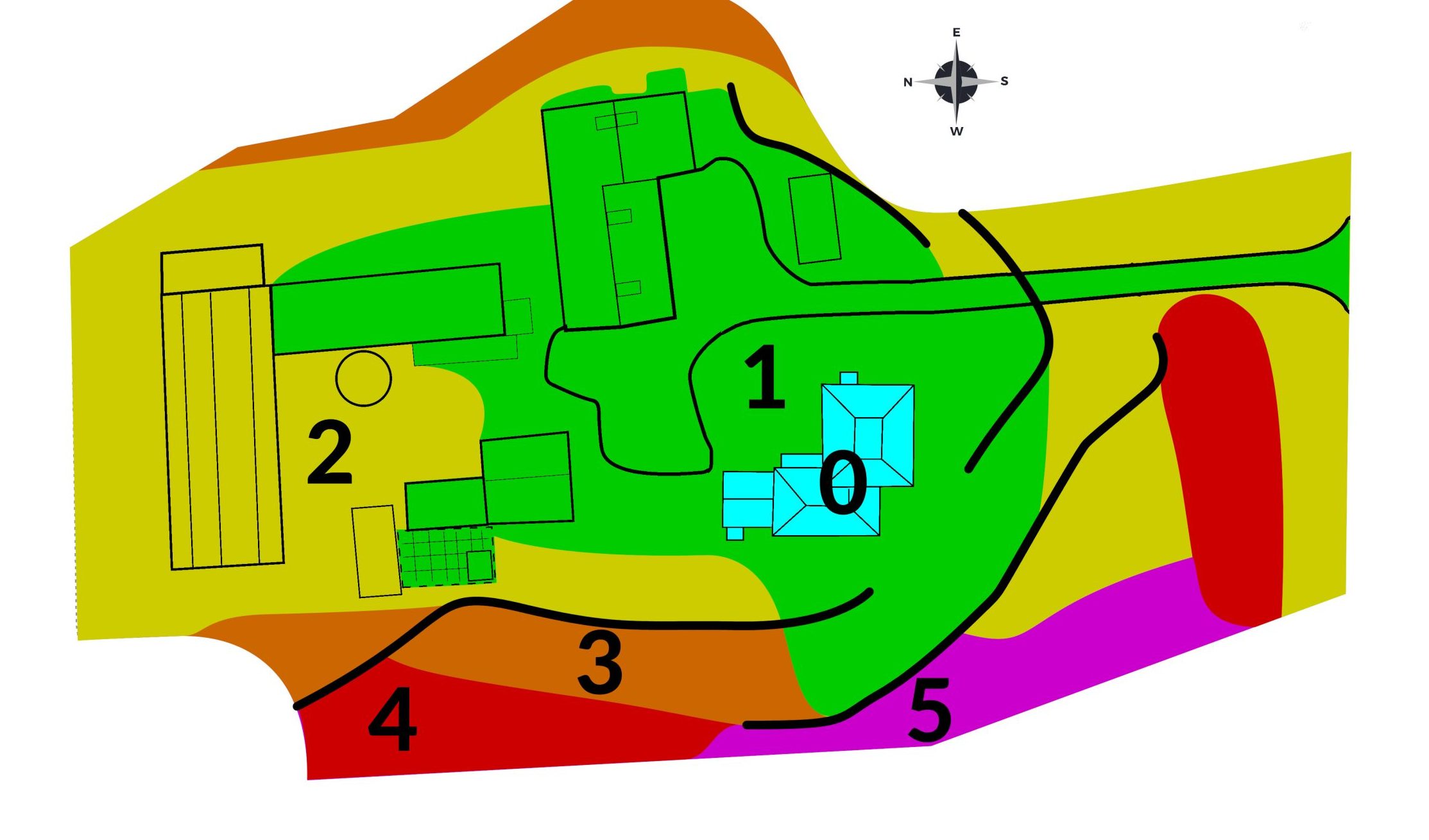In permaculture, when we go to design a site, one of the most important things we use to organize our design process is a the concept of zones. The zones are numbered from 0 to 5, where 0 is inside a residence, and 5 is untouched natural landscape. Each zone requires its own design approach. Any zone may be left out of the design, depending on the needs of the client.
Zone 0 design is mainly focused on the energy flows and walking patterns within a house. The goal is for the house to be mostly self-heated and self-cooled. Windows are strategically placed. Orientation in relation to the sun is of critical importance. For instance, in the northern hemisphere, having bedrooms on the south side of the house can lead to some quite intense domestic unrest, because in the summer it’s far too warm to sleep, and everyone’s put in a bad mood. Having unshaded eastern windows in a bedroom can also be disastrous, making the possible consequences of oversleeping include sunstroke, and severe dehydration.
Zone 1 design is focused mainly on an extremely diverse, entirely mulched garden, that is quite intensive and produces a very large amount of food for it’s area. It is always very close to the house. This is always quite a small area, never bigger than 10 sotoks, and it’s the main source of food for the people who live on site. This is also the area where you have a place for barbecues, a patio, detskaya ploschadka etc. If you have fruit trees here they are dwarf or semi-dwarf, and they are often multi-grafted. Within zone 1 there may be quiet animals, like rabbits and a vermiculture composting system. This zone is usually behind a living wind break on at least three sides. At the outer edge of zone 1 is where you have your chickens.
Zone 2 design is mainly focused on providing a few staples. In colder climates, a lot of storage crops will be grown here. Anything that is only harvested once, such as a grain crop for domestic consumption may grow here. This is where the most diverse food forest on the site will be. (I will get to food forests in a later issue) In zone 2, you may grow stick fuels. Zone 2 provides animals like chickens with a place to forage from, and provides a base of ecological stability for Zone 1. If you have tillage anywhere, zone 2 is the most likely place for it to be, because it’s limited in scale.
Zone 3 design can be a really expansive area,and it is focused on agricultural production, usually for sale. It’s the most likely zone to be left out of a design, because not everyone wants to be a farmer. This is where you have your pasture paddocks for cows and sheep and chickens. This is where you have your largest crop fields. This is the other zone where tillage might be used, but here it’s more risky, since it can be on a large enough scale to be really damaging. Many times, people will use pigs for tillage here, or use no-till strategies of growing annuals or move to mostly perennial systems. There are some quite specific strategies in this zone for different kinds of production. This is the zone where you start really looking for ways to partner with a larger ecosystem. You may also have food forests here. They will be made up of hardier species than those in zone 2. Here you want elements that don’t need any special care.
Zone 4 design is mainly about establishing forest, and deciding what kind of forest we want it to be. There are timber forests and nut forests and forage forests for animals like turkey, pheasant, pig and quail, there are mushroom forests and firewood forests and honey forests and syrup forests. It’s just a matter of getting them going, and after that, there’s virtually no maintenance.
Zone 5 design is purely about location and shape. Zone 5 is not managed, but left completely alone to follow its natural evolution. It usually becomes a forest eventually. Zone 5 is for recreation, some low-impact foraging and hunting, and mostly observation. Zone 5 will eventually become rich in species, but it may take longer to start building soil than the other zones. One indicator that you’re doing the right thing is that you’re building soil faster than in zone 5. If there is some metric by which zone 5 is outpacing you, you need to rethink your system. Zone 5 is the teacher. There are infinite lessons about the world in this natural system. Passive observation in zone 5 is what keeps you anchored to the natural world. Zone 5 can be used in various ways. If someone loves watching wildlife, a corridor of zone 5 with some specific plantings on the edges of this corridor can bring the deer right to his back porch. Zone 5 may be chosen based on terrain. There may be some quite steep slopes on a site that are not stable under any kind of productive use. But they function very well as zone 5.
The zones all have close interactions between each other. They function as an interface between man and nature, with the innermost zone being completely dependent on man to function, and the outermost zone being completely independent of man. The zones in between are, ecologically speaking, a gradient between those two extremes.

Leave a Reply